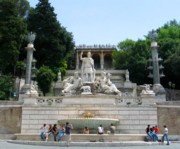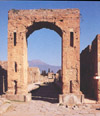
SHORE EXCURSION FROM THE PORT OF CIVITAVECCHIA TO ROME FOR DISABLED (COLISEUM, TREVI FOUNTAIN, PIAZZA DI SPAGNA)
Details
PRIVATE SHORE EXCURSION FROM THE PORT OF CIVITAVECCHIA TO ROME FOR DISABLED (Coliseum, Forum, Palatino, Fountain of Trevi, Piazza di Spagna and Piazza del Popolo)
|
DURATION: | 9 hours | |
|
PRICE: |
View the price list | |
|
AVAILABILITY: |
All-year-round | |
|
THE PRICE INCLUDES: | English-speaking Driver & Accessible air-conditioned Mercedes Car at your disposal for 9 hours THE ENTRANCE FEES AND THE RESERVATION FOR THE COLISEUM, THE ROMAN FORUM AND THE PALATINE HILL ARE INCLUDED! | |
SCHEDULE OF THE SHORE EXCURSION TO ROME FROM CIVITAVECCHIA PORT
|
| Meet with the English-speaking driver and his accessbile Mercedes car (with air conditioning) by the cruise ship at the Port of Civitavecchia |
| Arrival in Rome and meet with our English-speaking expert guide at the Coliseum area |
| 3-hour guided visit of the Coliseum, Foro Romano and Palatino |
| 1 hour free time for lunch (not included in the price) |
| Pick-up with our English-speaking driver (without guide) and short drive to reach the Trevi Fountain in the centre of Rome |
| 2 hours of free time for the visit of the Trevi Fountain, the Spanish steps and Piazza del Popolo (without guide) |
| Pick-up close to Piazza del Popolo and back to the Port of Civitavecchia |
All the the monuments included in this Tour are equipped to accommodate people with reduced mobility.
Together with our English-speaking expert guide you’ll discover the treasures of the Eternal city:
Our tour will start by the visit of the Coliseum, one of the greatest wonders of Roman civilization.
The imposing remains of this immense amphitheatre still allow us to admire its ancient splendor. It was built by Jewish prisoners. Its true name is the “Flavian Amphitheatre”, though it was commonly called the Coliseum, both for its proportions and its vicinity to the Colossus of Nero. There is hardly a page of Roman history that is not in some way connected to the Coliseum, which became the symbol of the city and its life.
Right next to the Coliseum is the Roman Forum, the monumental complex whose remains lie between the Capitol Hill, the Imperial Fora, the Coliseum and the Palatine Hill. The centre of the civic and economic life in Republican times, the Forum maintained an important role also in the Imperial period. With the fall of the Roman Empire in the west, however, it went decline. An earthquake in 851 during the papacy of Leo IV caused extensive damage, but the decisive blow was the devastating fury of the Normans who, although they came to Rome in 1084 ostensibly to help Pope Gregory VII, sacked and set fire to the city.
The Forum was crossed by the Via Sacra, which led to the Capitol Hill and also served as the route of the triumphal processions of victorious generals laden with booty and followed by ranks of prisoners. While the oldest sections of the Forum (built in the Republican era) stretched from the opposite side of the valley to the edge of the Capitol Hill, the entrance on the square of the Coliseum leads to the most recently built section, which dates from the Imperial Age. On the Via Sacra, at the top of the Velia, is the Arch of Titus, which the Senate built after the Emperor’s death in memory of his conquest of Jerusalem. On the inside of the arch are two fine bas-reliefs: the Emperor on his triumphal chariot and the procession of the Jewish prisoners carrying a seven branched candelabrum.
The Temple of Antoninus and Faustina is the best preserved building in the Forum. This temple was transformed in the middle ages into the church of “San Lorenzo in Miranda”.
Many pagan temples were converted into Christian churches, including the ancient Church of St. Cosmos and Damian, built in 572 by Felix IV inside the “Templum Sacrae Urbis” which the Emperor Vespasian had constructed in the adjacent “Forum of Peace” (or “Vespian’s Forum”).
Another historic Roman hill, the Palatine, faces the Forum, preserving unforgettable memories in its luxuriant vegetation. The Palatine was the centre of Rome in two distinct periods: that of the Roman Kings and of the Empire. During the republic the Palatine was home to patrician families: Quintus Hortensius, the celebrated orator who emulated Cicero, had a house here which later was acquired and enlarged by Augustus. As soon as Augustus became Emperor, he made his Imperial residence on the Palatine. Subsequently, Tiberius, Caligula, the Flavii and finally Septimus Severus built palaces here.
After the 1 hour free time you’ll be picked up by our driver. After a short drive we’ll reach the centre of Rome were you’ll have 2 hours free time for the visit of the Trevi Fountain, Piazza di Spagna and Piazza del Popolo.
The Trevi Fountain is Rome’s most sumptuous fountain. Of course, you have to toss a coin in the Trevi. To do it properly (Romans are superstitious), hold the coin in your right hand, turn your back to the fountain, and toss the coin over your left shoulder. According to traditions, the spirit of the fountain will then see to it that you return to Rome one day.
The world famous Piazza di Spagna with the Spanish Steps rising from the piazza, are the meeting place of Rome. In spring, the steps are decorated with colorful azaleas, but in any season the square is atmospheric – though you can hardly see it when it’s covered with wall-to-wall tourists, lovers, backpackers, Roman youth, and so on. The atmosphere is festive and convivial, though. The piazza’s name comes from the 15th century, when the Spanish ambassador made his residence here. In those days, the piazza was far less hospitable (People passing through the piazza at night sometimes disappeared. Because it was technically Spanish territory, the unwary could be pressed-ganged into the Spanish army). The area’s most famous resident was English poet John Keats, who lived and died in the house to the right of the steps, which is now the Keats-Shelley House. The real name of the steps isn’t the Spanish Steps but the Scalinata della Trinità del Monte, because they lead to the Trinità del Monte church, whose towers loom above. At the food of the steps, the boat-shaped fountain by Pietro Bernini, father of Gian Lorenzo, is one of the most famous in Rome.
Another place that you should have seen at your stay in Rome is the vast, architecturally superb and perfectly symmetrical Piazza del Popolo which was designed by Valadier at the beginning of the 19th century. At the centre is the second Obelisk brought to Rome by Augustus, which was erected here by Fontana during the papacy of Sixtus V.
The Tour ends at Piazza del Popolo from where you’ll be picked up by our bus driver for the return to Civitavecchia.
SUGGESTIONS:
Take water, camera & sun cream. In low season warmer clothing may be required!












